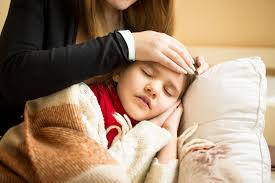
Introduction
A fever is when your child’s body temperature is higher than 38°C. A normal temperature range for children is 36.5°C-38°C.
Fever is not an illness in itself, but is the sign of an illness.
Signs and Symptoms of fever.
High body temperature.
Typical signs include,
a red face, tired-looking
or glazed eyes.
pale skin.
A hot forehead or neck can also be a sign of fever.
Some children lose their appetite or cry a lot.
It’s important to take the child to see a nurse or a doctor if;
Their temperature is above 39°C (102.2°F) or a baby under three months old has a temperature above 38°C (100.4°F),
The fever comes and goes,
The fever lasts longer than three days,
They have a febrile seizure,
They have a stiff neck, are unresponsive, restless or confused,
They vomit, have diarrhea or pain in their belly,
They have a skin rash,
They refuse to suckle breast or drink over a long period of time or
Their condition has worsened since the last visit to the doctor.
Pathophysiology of fever
Pathophysiology of Fever in Infants and Children.
Fever occurs during infection, bacterial and viral products, such as bacterial lipopolysaccharide (LPS), cause the release of cytokines from immune cells. in response to the release of endogenous pyogenic mediators called cytokines (in particular interleukin-1 [IL-1]). Cytokines stimulate the production of prostaglandins by the hypothalamus; prostaglandins readjust and elevate the temperature set point.
Fever plays an integral role in fighting infection and, although it may be uncomfortable, does not necessitate treatment in an otherwise healthy child. Some studies even indicate that lowering the temperature can prolong some illnesses. However, fever increases the metabolic rate and the demands on the cardiopulmonary system. Therefore, fever can be detrimental to children with pulmonary or cardiac compromise or neurologic impairment. It can also be the catalyst for febrile seizures , a typically benign childhood condition.
Fever occurs when an area in your brain called the hypothalamus — also known as your body’s “thermostat” — shifts the set point of your normal body temperature upward. When this happens, the child may feel chilled and add layers of clothing or wrap up in a blanket, or the child may shiver to generate more body heat, eventually resulting in an elevated body temperature.
Normal body temperature varies throughout the day — it’s lower in the morning and higher in the late afternoon and evening. Although most people consider 98.6 F (37 C) normal, your body temperature can vary by a degree or more — from about 97 F (36.1 C) to 99 F (37.2 C) — and still be considered normal.
Fever or elevated body temperature might be caused by:
Gastroenteritis
Common colds, influenza and other upper respiratory tract infections
Diseases like chickenpox, measles and mumps
Ear and throat infections like middle ear infection and tonsillitis.
Malaria parasite.
Urinary tract infections in babies and toddlers and urinary tract infections in children.
Pneumonia
A virus
A bacterial infection
Heat exhaustion
Certain inflammatory conditions such as rheumatoid arthritis — inflammation of the lining of your joints (synovium)
A malignant tumor.
Some immunizations, such as the diphtheria, tetanus and acellular pertussis (DTaP) or pneumococcal vaccine.
Sometimes the cause of a fever can’t be identified. If you have a fever for more than three weeks and your doctor isn’t able to find the cause after extensive evaluation, the diagnosis may be fever of unknown origin
Complications of fever in children
Fever can lead to dehydration (too little fluid in the body). Medical attention is needed if the child refuses to drink or shows signs of dehydration, such as the following:
A sunken fontanel (soft spot on the top of the baby’s head)
A dry mouth and dry lips
Sunken eyes
Lack of tears
The child generally looks very ill.
Fever can sometimes lead to a febrile seizure (also known as a febrile convulsion) – particularly in children between the ages of three months and five years. Although simple febrile seizures can be very alarming, they usually only last a few minutes , But it is still very important to take the child to the hospital immediately.
Diagnosis of febrile condition
To evaluate a fever, your nurse or doctor may:
Ask questions about your child symptoms and medical history
Perform a physical exam
Recommend some tests, such as malaria parasites, full blood counts or a chest X-ray, as needed, based on your medical history and physical examination.
They can then use a thermometer to measure the child’s temperature – ideally three times a day, if possible. The best way to get reliable readings is by inserting a digital thermometer into the child’s anus (rectal temperature).
Treatment
For a low-grade fever, your nurse or doctor may not recommend treatment to lower your body temperature. These minor fevers may even be helpful in reducing the number of microbes causing your illness.
Over-the-counter medications.
In the case of a high fever or a low fever that’s causing discomfort, your nurse or doctor may recommend an over-the-counter medication, such as acetaminophen (paracetamol) or Ibuprofen (NSAID)
Use these medications as recommended by your Clinician.
Be careful to avoid taking too much. High doses or long-term use of paracetamol or ibuprofen may cause liver or kidney damage, and acute overdoses can be fatal. If your child’s fever remains high after a dose, don’t give more medication; call your nurse or Doctor instead.
Don’t give aspirin to children, because it may trigger a rare, but potentially fatal, disorder known as Reye’s syndrome.
medications by prescription.
Depending on the cause of your fever, the medical practitioner may prescribe an antibiotic, especially if he or she suspects a bacterial infection, such as pneumonia or upper respiratory infections.
Antibiotics don’t treat viral infections, but there are a few antiviral drugs used to treat certain viral infections. However, the best treatment for most minor illnesses caused by viruses is often rest and plenty of fluids and treat asymptotically as viruses do run their course.
Treatment of infants
For infants and new born especially those younger than 28 days, the baby might need to be admitted to the hospital for diagnostic tests and treatment because fever could indicate a serious infection that requires intravenous (IV) medications and close monitoring.
Prevention
Fevers may be prevented by reducing exposure to infectious diseases or dirty .environmental.
Wash your hands often and teach your children to do the same, especially before eating, after using the toilet, after spending time in a crowd or around someone who’s sick, after petting animals, and during travel on public transportation.
Show your children how to wash their hands thoroughly, covering both the front and back of each hand with soap and rinsing completely under running water.
Always have your hand sanitizer with you for times when you don’t have access to wash your hands with the soap and water.
Avoid touching your nose, mouth or eyes, as these are the main ways that viruses and bacteria can enter your body and cause infection.
Avoid sharing cups, water bottles and utensils with your child or children
Cover your mouth when you cough and your nose when you sneeze and teach your children to do likewise. Whenever possible, turn away from others when coughing or sneezing to avoid passing germs along to them.
Ensure your child is immunized accordingly.
Protect the child from mosquito bites through the use of insecticide-treated net over the child’s bed, use gauze on doors and windows, avoid bringing out a child late in the evening and sanitize your environment especially the drainages.
Take home note
Home remedies like tepid sponging also helps to cool the child’s body temperature.
It’s more important not to dress the child too warmly, otherwise their body won’t be able to cool off. That is to avoid overdressing the child.
Avoid rubbing oil on the child skin as it entraps more heat to the child’s body.
Give copious(enough) fluid to Children who have a fever. So it’s important to make sure that children, including those that are breastfed, drink enough water and those breastfeeding should continue to breastfeed on demand.
A child that has a fever need medical attention.
If the child is placed on antibiotics ensure it is judiciously given.
Keep your child appointment with the clinic.
Always enquire about your child’s health information from the health workers not social media or neighbours.
Teething does not cause fever but because children are in their oral stage and they put almost everything their hands can grab into their mount coupled with their itching gum during teething ,dirts that they put in their mouth may cause infection which results to illness and manifests as fever.
Protect the child from mosquito bites through the use of insecticide-treated net over the child’s bed, use gauze on doors and windows, avoid bringing out a child late in the evening and sanitize your environment especially the drainages.


2 thoughts on “Fever In children ( High Body Temperature)”
I like the helpful info you provide in your articles. I will bookmark your
blog and check again here frequently. I am quite certain I’ll learn many new
stuff right here! Best of luck for the next!
Look at my web page how to get more followers on instagram
(https://wwd.com)
Having read this I believed it was very informative.
I appreciate you taking the time and energy to put this information together.
I once again find myself spending a significant amount of time both reading and commenting.
But so what, it was still worthwhile!
Visit my website; gold ira